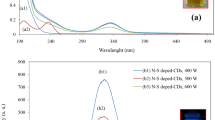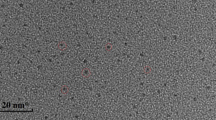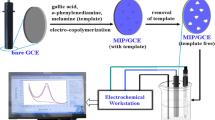Abstract
A carbon dot (CD) was prepared by o-phenylenediamine and water, which showed bright yellow fluorescence under ultraviolet light irradiation (λ = 580 nm), and verified good fluorescence quenching effect on penicillin G sodium (Png-Na). Using methacrylic acid as a functional monomer, ethylene glycol dimethacrylate as a crosslinker, and Png-Na as a template, a kind of composite microsphere combining CD and molecularly imprinted polymer (MIP) was synthesized by surface-initiated atomic transfer radical polymerization (SI-ATRP). For reasons of comparison, we also prepared MIP without CD and non-imprinted polymers (NIPs). Through static and dynamic adsorption experiments, the maximum adsorption capacity was 47.05 mg g−1 and the equilibrium time was 30 min. High-performance liquid chromatography (HPLC) was utilized to determine the content of Png-Na in the spiked milk samples. A sensitive, rapid, and simple method for determination of Png-Na in food samples was developed. The utilized approach enabled the quantification of Png-Na within the concentration range 20–1000 μg L−1 (with a limit of detection of 5 μg L−1). The recoveries achieved were in the range 93.3–98.2%, with a relative standard deviation of 1.2–4.2%. The results demonstrated that CD@MIP possessed the capability of specific adsorption and fluorescence detection of Png-Na, enabling simultaneous detection and enrichment of Png-Na in real samples.
Graphical abstract







Similar content being viewed by others
Data availability
All data generated or analyzed during this study are included in this published article and its supplementary information files.
References
Pennacchio A, Varriale A, Scala A, Marzullo VM, Staiano M, D’Auria S (2016) A novel fluorescence polarization assay for determination of penicillin G in milk. Food Chem 190:381–385
Jiang X, Qin X, Yin D, Gong M, Yang L, Zhao B, Ruan W (2015) Rapid monitoring of benzylpenicillin sodium using Raman and surface enhanced Raman spectroscopy. Spectrochim Acta A 140:474–478
Thavarungkul P, Dawan S, Kanatharana P, Asawatreratanakul P (2007) Detecting penicillin G in milk with impedimetric label-free immunosensor. Biosens Bioelectron 23:688–694
El-Moghazy AY, Zhao C, Istamboulie G, Amaly N, Si Y, Noguer T, Sun G (2018) Ultrasensitive label-free electrochemical immunosensor based on PVA-co-PE nanofibrous membrane for the detection of chloramphenicol residues in milk. Biosens Bioelectron 117:838–844
Cao Y, Su X, Wang Q, Xue H, Zhu X, Zhang C, Jiang J, Qi S, Gong X, Zhu X, Pan M, Ren H, Hu W, Wei Z, Tian M, Liu W (2017) A multicenter study evaluating ceftriaxone and benzathine penicillin G as treatment agents for early syphilis in Jiangsu, China. Clin Infect Dis 65:1683–1688
Luton E, Memphis M (1964) Methicillin tolerance after penicillin G anaphylaxis. JAMA 190:151–152
Karageorgou E, Christoforidou S, Ioannidou M, Psomas E, Samouris G (2018) Detection of beta-Lactams and chloramphenicol residues in raw milk-development and application of an HPLC-DAD method in comparison with microbial inhibition assays. Foods 7:82
Norzaee S, Taghavi M, Djahed B, KordMostafapour F (2018) Degradation of penicillin G by heat activated persulfate in aqueous solution. J Environ Manage 215:316–323
Zhou S, Wang D, Zhao Y, Wu Y (2015) A rapid HPLC method for indirect quantification of beta-lactamase activity in milk. J Dairy Sci 98:2197–2204
Santos R, Limas E, Sousa M, da Conceição CM, Ramos F, da Silveira MIN (2007) Optimization of analytical procedures for GC–MS determination of phytosterols and phytostanols in enriched milk and yoghurt. Food Chem 102:113–117
Delatour T, Savoy M-C, Tarres A, Bessaire T, Mottier P, Desmarchelier A (2018) Low false response rates in screening a hundred veterinary drug residues in foodstuffs by LC-MS/MS with analyte-specific correction of the matrix effect. Food Control 94:353–360
Andreou C, Mirsafavi R, Moskovits M, Meinhart CD (2015) Detection of low concentrations of ampicillin in milk. Analyst 140:5003–5005
Wang Y, Zhang X, Pan Y, Chen Y (2017) Analysis of oil content in drying petroleum sludge of tank bottom. Int J Hydrogen Energ 42:18681–18684
Hao HX, Zhou H, Chang J, Zhu J, Wei TX (2011) Molecularly imprinted polymers for highly sensitive detection of morphine using surface plasmon resonance spectroscopy. Chinese Chem Lett 22:477–480
Madikizela LM, Tavengwa NT, Tutu H, Chimuka L (2018) Green aspects in molecular imprinting technology: from design to environmental applications. Trends Environ Anal 17:14–22
Keçili R, Hussain CG, Hussain CM (2023) Emerging trends in green carbon dots coated with molecularly imprinted polymers for sensor platforms. Trac-Trend Anal Chem 166:117205
Wang Y, Wei T-X (2013) Surface plasmon resonance sensor chips for the recognition of bovine serum albumin via electropolymerized molecularly imprinted polymers. Chinese Chem Lett 24:813–816
Matyjaszewski K (2018) Advanced materials by atom transfer radical polymerization. Adv Mater 30:1706441
Li Q, Zhang W, Liu X, Zhang H (2022) Preparation of complex biological sample-compatible “turn-on”-type ratiometric fluorescent molecularly imprinted polymer microspheres via one-pot surface-initiated ATRP. Microchim Acta 189:464
Li X, Pan J, Dai J, Dai X, Xu L, Wei X, Hang H, Li C, Liu Y (2012) Surface molecular imprinting onto magnetic yeast composites via atom transfer radical polymerization for selective recognition of cefalexin. Chem Eng J 198–199:503–511
Peng Z, Han X, Li S, Al-Youbi AO, Bashammakh AS, El-Shahawi MS, Leblanc RM (2017) Carbon dots: biomacromolecule interaction, bioimaging and nanomedicine. Coordin Chem Rev 343:256–277
Zhu X, Yuan X, Han L, Liu H, Sun B (2021) A smartphone-integrated optosensing platform based on red-emission carbon dots for real-time detection of pyrethroids. Biosens Bioelectron 191:113460
Wang R, Lu K-Q, Tang Z-R, Xu Y-J (2017) Recent progress in carbon quantum dots: synthesis, properties and applications in photocatalysis. J Mater Chem A 5:3717–3734
Roy P, Chen P-C, Periasamy AP, Chen Y-N, Chang H-T (2015) Photoluminescent carbon nanodots: synthesis, physicochemical properties and analytical applications. Mater Today 18:447–458
Wu Q, Wang X, Rasaki SA, Thomas T, Wang C, Zhang C, Yang M (2018) Yellow-emitting carbon-dots-impregnated carboxy methyl cellulose/poly-vinyl-alcohol and chitosan: stable, freestanding, enhanced-quenching Cu2+-ions sensor. J Mater Chem C 6:4508–4515
Hao J, Wang F, Dai X, Gong B, Wei Y (2011) Preparation of poly(vinyltetrazole) chain-grafted poly(glycidymethacrylate-co-ethylenedimethacrylate) beads by surface-initiated atom transfer radical polymerization for the use in weak cation exchange and hydrophilic interaction chromatography. Talanta 85:482–487
Bai Q, Huang C, Ma S, Gong B, Ou J (2023) Rapid adsorption and detection of copper ions in water by dual-functional ion-imprinted polymers doping with carbon dots. Sep Purif Technol 315:123666
Wang H, Huang C, Ma S, Guo S, Gong B, Ou J (2023) Fabrication of bifunctional macroporous adsorption resin via grafting carbon dot and application in the detection and adsorption of iron (III) ion. Mater Today Commun 34:105220
Cai T, Zhou Y, Liu H, Li J, Wang X, Zhao S, Gong B (2021) Preparation of monodisperse, restricted-access, media-molecularly imprinted polymers using bi-functional monomers for solid-phase extraction of sarafloxacin from complex samples. J Chromatogr A 1642:462009
Jalili R, Khataee A, Rashidi MR, Razmjou A (2020) Detection of penicillin G residues in milk based on dual-emission carbon dots and molecularly imprinted polymers. Food Chem 314:126172
Pupin RR, Foguel MV, Gonçalves LM, Sotomayor M, d P T, (2019) Magnetic molecularly imprinted polymers obtained by photopolymerization for selective recognition of penicillin G. J Appl Polym Sci 137:48496
Rahim ZA, Yusof NA, Ismail S, Mohammad F, Abdullah J, Rahman NA, Abubakar L, Soleiman AA (2023) Functional nano molecularly imprinted polymer for the detection of penicillin G in pharmaceutical samples. J Polym Res 30:113
Rahdar S, Rahdar A, Khodadadi M, Ahmadi S (2019) Error analysis of adsorption isotherm models for penicillin G onto magnesium oxide nanoparticles. Appl Water Sci 9:190
Lu X, Xing H, Su B, Yang Y, Ren Q (2009) Adsorption behavior of penicillin G sodium on hydrophilic gel toyopearl HW-40F. J Chem Eng Data 54:1052–1053
Li X, Zhang N, Yang L (2020) Adsorption of ampicillin sodium on activated carbons with different surface chemistries. IOP Conf Ser: Earth Environ Sci 467:012184
Acknowledgements
Financial support is gratefully acknowledged from the CAS-Weigao Research & Development Program ([2017]-009) and the National Natural Sciences Foundation of Ningxia (No. 2021AAC02017) to J. Ou.
Funding
This work was supported by National Natural Sciences Foundation of Ningxia, No. 2021AAC02017, Junjie Ou, The CAS-Weigao Research & Development Program, [2017]-009, Junjie Ou.
Author information
Authors and Affiliations
Corresponding authors
Ethics declarations
Ethical approval
This research did not involve human or animal samples.
Conflict of interest
The authors declare no competing interests.
Additional information
Publisher's Note
Springer Nature remains neutral with regard to jurisdictional claims in published maps and institutional affiliations.
Supplementary Information
Below is the link to the electronic supplementary material.
Rights and permissions
Springer Nature or its licensor (e.g. a society or other partner) holds exclusive rights to this article under a publishing agreement with the author(s) or other rightsholder(s); author self-archiving of the accepted manuscript version of this article is solely governed by the terms of such publishing agreement and applicable law.
About this article
Cite this article
Xu, Y., Wang, H., Bai, Q. et al. Selective adsorption and identification of penicillin G sodium in milk by molecularly imprinted polymer doped carbon dot. Microchim Acta 191, 186 (2024). https://doi.org/10.1007/s00604-024-06269-5
Received:
Accepted:
Published:
DOI: https://doi.org/10.1007/s00604-024-06269-5




